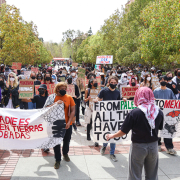Researchers track ongoing destruction in Ukraine
Associate professor Sylvain Barbot published a study on the impact of the war.
By ERIN YOON
In the span of 16 seconds, an entire country disappears. Around it, seven bordering countries remain unchanged.
This is a video of the nighttime light data from Ukraine between January 2022 and April 2023 put together by associate professor of earth sciences Sylvain Barbot and Peking University researchers Hang Xu and Teng Wang, exposing the decrease in night light activity in Ukraine as Russia’s war in Ukraine has progressed.
Daily headlines, sent straight to your inbox.
Subscribe to our newsletter to keep up with the latest at and around USC.
Using only open-access data available to the public, Barbot, Xu and Wang published a study mapping the destruction from the Russia-Ukraine War Jan. 11. The study, “Remote sensing through the fog of war: Infrastructure damage and environmental change during the Russian-Ukrainian conflict revealed by open-access data,” offers visual representations of Russia’s ongoing war in Ukraine.
Barbot said he felt he needed to take action when Russia invaded Ukraine in February 2022 because it ended the longest period of peace in Europe since the Pax Romana in 27 BCE. As Barbot closely followed the details of the clash, he “felt violated.” Ukrainian President Volodymyr Zelenskyy put the number of deceased Ukrainian soldiers at 31,000 as of February 25, declining to disclose the number of wounded, while a U.S. intelligence report put Russian soldier casualties and injuries at 315,000 as of December 2023.
“I feel that the war is the antithesis of what the world is trying to do today, which is build[ing] a more just society and trying to tackle the world’s biggest problems,” Barbot said. “That the country would decide like that to start a high-intensity war with artillery, infantry, tens of thousands of people dying, it seems so barbaric and contrary to the modern trends. And yet, it’s happening.”
Short of enlisting as a soldier for Ukraine, Barbot was searching for any approaches he could take to aid the Ukrainian effort.
“I’m a geologist, so at first glance, it looks like I can’t do anything, but it turns out I have a lot of transferable skills that can be used to monitor military conflicts, and I’m an expert in [the] use of satellite images,” Barbot said. “Usually, I monitor volcanoes and earthquakes and natural hazards, but you can turn the satellite somewhere else and see what happens.”
On a visit to Beijing, Barbot spoke to fellow researchers Xu and Wang about applying their skills to the war in Ukraine. Starting last June, the team relied on three main sources of information to create a complete picture of the changes that occurred in the country, each focusing on different scales of destruction.
They first analyzed nighttime lights data from the Visible Infrared Imaging Radiometer Suite obtained from NASA’s Black Marble dataset, which documented the sharp decrease in light activity during the night in non-occupied areas of Ukraine. Barbot attributed this change to Russian attacks on the power grid, Ukrainian blackout regulations that lessen the risk of civilian buildings being bombed, and the mass migration of Ukrainians to other countries.
The team then used Synthetic Aperture Radar data from the European Space Agency’s Copernicus Copernicus Open Access Hub, specifically from their Sentinel-1 satellite, to make images and animations that depicted the gradual destruction of Ukrainian infrastructure.
Finally, they used optical satellite images from satellites Sentinel-2 and Landsat, available from the ESA’s Copernicus Copernicus Open Access Hub and the United States Geological Survey, respectively. This type of satellite offers a more macro view which Barbot, Xu and Wang used to map the devastation of Ukraine’s natural environment.
The team decided to use these three sources of information since they offered varying views of one conflict, allowing for cross-comparisons and a guarantee of factuality. According to Barbot, the influx of propaganda on technology transformed the conflict into one that was “enacted [on] social media.”
Florian Primig, a research associate at Freie Universität Berlin, has extensive experience in the spread of false information on social media as an associate researcher in the research group “Digital News Dynamics” at the Weizenbaum Institute for the Networked Society. He worked on a similar study, “Remixing war: An analysis of the reimagination of the Russian–Ukraine war on TikTok,” that examined how the war in Ukraine has been depicted on TikTok.
“It’s almost impossible to mitigate that risk [of propaganda] with fact-checking or regulative efforts because the idea that all lies and propaganda in war are disseminated by a coordinated few institutional professionals would be naïve,” Primig said. “The war on platforms is co-created by everyday users competing in the abundance of sharing what they perceive the war to be.”
The newfound ease of spreading disinformation online was a driving force for the study; Barbot said their results differ from information on social media as there is “a guarantee of factuality.”
Though the data the researchers used is open access and available to anyone, Barbot said it is difficult for the public to interpret. As a result, the team created simpler visualizations of the facts to make the data more accessible to the public.
Sylvain Barbot, Hang Xu and Teng Wang visualized the destruction of infrastructure in the Ukrainian city of Bakhmut. (Sylvain Barbot, Hang Xu & Teng Wang)
Corey Scher of New York’s City University of New York Graduate Center has been mapping Ukraine for the past two years. He also began mapping Gaza at the onset of the 50-day war between Hamas and Israel in 2014. He recently conducted multiple trainings with NASA, teaching humanitarian practitioners the basics of creating maps from openly accessible satellite imagery.
“A big passion of mine is translating, making these methods more accessible and available to a community that’s beyond just the geophysical community so that we can democratize access to this type of information,” Scher said.
He drew similarities between the tactics he taught in the sessions with Barbot’s paper, emphasizing the importance of increasing satellite image literacy.
For both Scher and Barbot, the results of their satellite mapping were chilling — Scher described his work as “very tragic to think about.”
“When the graduate student Hang Xu did the first images and we sat together and looked at [them], it looked like a checkerboard [or] a grid. We were very puzzled by this. ‘What have you done? It looks like you have drawn some lines through the city,’” Barbot said. “We looked at this more closely and we’re like, ‘Oh, what we’re looking at is the road system and every building between the roads has collapsed.’”
What the research team was looking at was a visualization of the utter destruction in the 400-year-old Ukrainian city of Bakhmut, the progression of Russian troops leaving nothing but roads.
“We were indeed looking at buildings collapsing [and] blowing up, entire cities being completely flattened week after week, for a month at a time, neighborhoods going away … [It] was sobering to look at,” Barbot said. “Tens of thousands of people died in these battlefields. It was not like assessing earthquakes at all. People die from that, too … but they usually don’t volunteer to do it.”
Analysis of the nighttime lights data revealed a similar story of destruction and fear. Barbot, Xu and Wang found significantly reduced levels of nighttime light in non-occupied areas of Ukraine, while the occupied areas of Luhansk, Donetsk, Melitopol, Simferopol and Sebastopol in Crimea experienced no change in nighttime light activity. Crimea, largely unaffected, remains a popular tourist spot.
“You have this world that lives like nothing happened on one side, and then on the other, it’s blacked out, the whole country, except some major cities, which I can only suspect is because they have anti-missile protections, which allows them to continue living a little bit like usual, even though you can see from space it’s not the same luminosity, so it’s still reduced compared to before the war,” Barbot said.
Mapping military conflicts has serious implications. Taking the time to consider the true meanings behind the work can lead to emotional difficulties; Scher said multiple of his colleagues had to stop mapping wars because of the emotional toll.
“It’s hard to think about, whatever the context is, when you’re looking at something that is representative of loss. A damaged building or a destroyed building is just a proxy for everything else that’s going on on the ground: displacement, pain, suffering,” Scher said. “There are humans just caught in the middle of all this.”
Teng Wang, an assistant professor at the School of Earth and Space Sciences at Peking University in Beijing, China, came to a similar conclusion at the end of his work on the study.
“The takeaway message is clear that the open-source remote-sensing imagery allow[s] neutral scientists and technicians to map the evolution of a war with high resolution,” Wang said. “I hope [what] the public can learn from this study is as we stated in the paper: The real story of a war is simply destruction, no winner.”
DONATION PLUG – PLEASE DO NOT TOUCH
Thank you for reading the Daily Trojan.
We are the only independent newspaper here at USC, run at every level by students. That means we aren’t tied down by any other interests but those of readers like you: the students, faculty, staff and South Central residents that together make up the USC community.
Independence is a double-edged sword: We have a unique lens into the University’s actions and policies, and can hold powerful figures accountable when others cannot. But that also means our budget is severely limited. We’re already spread thin as we compensate the writers, photographers, artists, designers and editors whose incredible work you see in our daily paper; as we work to revamp and expand our digital presence, we now have additional staff making podcasts, videos, webpages, our first ever magazine and social media content, who are at risk of being unable to receive the support they deserve.
We are therefore indebted to readers like you, who, by supporting us, help keep our paper daily (we are the only remaining college paper on the West Coast that prints every single weekday), independent, free and widely accessible.
Please consider supporting us. Even $1 goes a long way in supporting our work; if you are able, you can also support us with monthly, or even annual, donations. Thank you.









